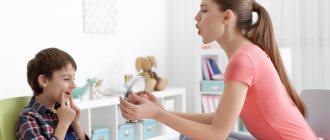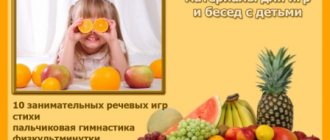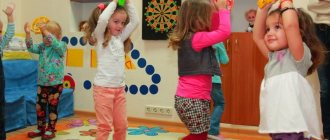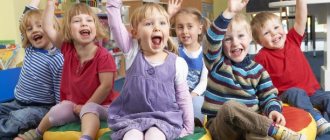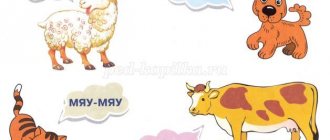Open lesson on logorhythmics in the senior group
Scenario for an open lesson on Logori.
Description of the material: Every year our holding hosts Open Days, the purpose of which is to introduce parents to specialists and teachers of additional education, as well as to the methods used in working with children. We present various areas (artistic and aesthetic, creative, physical education, educational) in the form of master classes and open classes. My circle on musical logorhythmics belongs to the artistic and aesthetic cycle and, thinking through the course of the lesson, I decided to devote it to a conversation about rhythm and ways to develop a sense of rhythm in children. Author: Olga Vasilievna Podkolzina, music director of the State Budgetary Educational Institution “School No. 1056” in Moscow. Goal: To interest parents and children in the subject of logorhythmics. Objectives: introduce rhythm games; show ways to develop a sense of rhythm in a child; create a relaxed gaming atmosphere.
Progress of the event
Guests (parents with children) enter the hall to the music. Musical director: Hello, my friends, I am glad to see you all. Our garden is open to guests, parents and their children. I suggest you stand in a circle and start our fun lesson! (Everyone stands in a circle.)
And before we start, we need to greet each other.
Communication game “Hello, friend!” M.Yu. Kartushina 1. The legs walked (Children and parents move scattered around the hall.)
Straight along the path, They met a friend
(Towards the end of the verse they stand in pairs.)
Little legs.
Chorus: Hello, hello, (Holding hands, couples perform a “spring”)
Hello, dear friend, Hello, hello,
(Do a “spring”).
Look around!
(Spread their arms to the sides).
Hello, hello,
(They make a “spring”).
Smile at me!
(Pretend to smile by raising your hands to your chin.)
Hello, hello,
(They make a “spring”).
Bow your head!
(Bow to each other).
2. The legs ran
(They run on their toes scattered around the hall).
Right along the path, Met a friend
(Get into pairs).
Little feet.
Chorus. (Movements are repeated).
3. The legs jumped
(they move around the hall in jumps, kids jump on two legs).
Right along the path, Met a friend
(By the end of the verse they get into pairs).
Little feet.
Chorus. (Movements are repeated). Musical director: Well, now that we have all said hello, I would like to talk to you a little about logorhythmics, about rhythm in general and how you can play with it. What is logorhythmics? This is a system of motor exercises that are combined with words and music. Most often it is used in correctional pedagogy, as well as to stimulate the speech development of children. Rhythm is not only a musical concept, but also a sense of time in general. A good sense of rhythm helps children better master their native language, because our speech also consists of rhythmic formulas, in which stressed and unstressed syllables constantly alternate. If you transfer them to rhythm, you get an alternation of long and short durations. Let me give you an example. My name is Olga VasIlyevna. I will say my name like this - a long syllable and two short ones (ta-ti-ti), a long syllable and two short ones (ta-ti-ti). Now let's stand in a circle. And we'll read out your names. Game “Tap Your Name” Parents and children stand in a circle and pass the ball to the music. When the music ends, the one with the ball in his hands slaps his name. Musical director: You can also clap any poem familiar to the baby. Does everyone know the poem “Teddy Bear”? Let's try to tap him. The clubfooted bear (Ti-ti-ti-ti-Ta-ti)
is walking through the forest.
(Ti-ti-ti-ti-Ta)
Collects cones,
(Ti-ti-ti-ti-Ta-ti)
Sings songs.
(Tee-ti-ti-ti-Ta)
Suddenly a cone fell
(Ti-ti-ti-Ta-ti)
Right in the bear's forehead,
(Ti-ti-ti-ti-Ta)
The bear got angry
(Ti-ti-Ta-Ti-Ti-Ti-Ta
ti-ti-ta-ti) And stomp with your foot!
(Ti-ti-ti-ti-Ta) Musical director: In the development of children's speech, various finger games, pure tongues, and also speech games with movement are actively used, when all actions are performed in accordance with a given rhythmic pulsation. Here is an example of a pure tongue (you can use any problematic sounds for elaboration). Author's pure phrase [l, r, l', r'] La, la, la, (Children walk rhythmically in place).
Winter has come to us, Ra, ra, ra,
(Clap their hands).
Happy kids.
La, la, la, (Swing their lowered arms from side to side).
White earth, Rya, Rya, Rya,
(They rhythmically clench and unclench their fists, while lowering their hands down).
In the light of a lantern.
Musical director: And now I suggest you play a little more! Rhythmic game for younger preschoolers “Jumping” M.Yu. Kartushina 1. Spending, spending! (Children jump on two legs in all directions.)
Let's start jumping!
Jump and jump, jump and jump! You need to jump on your toes. 2. Spending, spending! (Standing still, clap their hands.)
Let's start the crackers!
Clap-clap, clap-clap! Hit your hands - clap-clap-clap! 3. Spending, spending! (They spin around with a stomping step).
Let's start twirling!
Tra-ta, tra-ta-ta! What a beauty! Musical game for middle-aged and older children “Snowball-Kolobok” M.Yu. Kartushina Children and parents stand in a circle and pass the “snowball” around the circle, rhythmically pronouncing the text.
The one who has “snowball” in his hands at the last words goes out with his mother in a circle and dances. Hello, hello, our snowball, Snowy, white bun!
He rolled along the path, and then stopped. Go out onto the path and dance with the snow! Musical director: And, of course, playing in an orchestra, dancing, and any musical rhythmic movements wonderfully develop a sense of rhythm. Let's take our instruments and imagine that we are real musicians. Participants in the meeting take the proposed instruments and perform the proposed piece in the orchestra. Orchestra (at the choice of the music director)
Musical director: And at the end of our meeting, I propose a fun dance. Communicative dance for demonstration (at the choice of the music director) Music director: Our meeting today has come to an end. I hope everyone found it interesting. They played with you happily and didn’t get bored at all, But the time has come to say: “Goodbye! Good morning!" Children and parents leave the hall.
We recommend watching:
The use of ICT in correctional work with preschoolers Summary of GCD in the junior group on logorhythmics Music lesson in the senior group “Spring melodies and sounds” Logorhythmic lessons in kindergarten in the senior group on the lexical topic “Autumn”
Similar articles:
Walk “Wind Watching” in the senior group
Observation in the senior group of kindergarten. It's frosty outside
How does logarithmics affect the development of a 3-4 year old child?
Children who practice logorhythmics are more graceful, rhythmic, and able to move expressively, sing and speak. If the unity of all components is observed, positive changes will not be long in coming.
The influence of classes on children's development:
- The child learns to make the correct speech exhalation.
- An ear for music develops.
- Children become more dexterous, large and fine motor skills improve.
- Overly active kids calm down, become more diligent, and slow children become cheerful and active.
- Articulatory motor skills develop, and the pronunciation of sounds becomes clearer.
- Strength, agility and endurance are formed, children acquire beautiful posture.
These classes are especially important during the period of speech development, when any delay in speech development entails consequences that are difficult to eliminate.
How are logorhythmics classes conducted with children 3-4 years old?
All logorhythmic exercises for children 3-4 years old are very simple and interesting; special training is not required to perform them. The adult shows and the child repeats after him. Children are not required to memorize and memorize the material; everything happens spontaneously. At first, a little help from an adult is required, but after a few lessons the kids can independently and accurately repeat the speech material.
In the video of the presentation of the song - a dramatization of the famous early childhood development teacher Zheleznova E.S.:
For a visible effect, you need to practice for at least 6-12 months, regularly conducting 2 classes per week. It is better to do this after a nap, although it all depends on the individual characteristics of the child. Children with stuttering and hesitation should practice logorhythmics at least 3-4 times a week.
Approximate structure of classes - exercises:
- Walking with tasks.
- For relaxation and tension.
- Articulation, breathing exercises.
- To develop attention and memory.
- Count from 1 to 10.
- Pronouncing the text of a poem with movements.
- On the formation of auditory attention.
- To develop a sense of rhythm, a sense of tempo.
- Singing.
- Finger gymnastics.
- Correction of incorrect pronunciation.
- To distinguish linguistic units.
Before conducting the classes, a little preparation is required - for each stage of the classes you need to select the appropriate soundtrack. It could be classics, children's songs, relaxation music, sounds of nature.
It is impossible to use a strictly defined lesson program; all lessons are adjusted to a specific child. If there are problems with motor skills - the proportion of corresponding exercises increases, sound pronunciation suffers the most - more time should be devoted to finger and articulatory gymnastics.
In no case should a child be scolded for failures, so that he does not lose interest in classes. It is better to abandon an unmastered exercise for a while, but then you still need to return to it.
What does logorhythmics mean? Characteristics and features
Many modern preschoolers are diagnosed with simultaneous delays in both speech and motor skills, two components that are closely related to each other. Logorhythmics, or speech therapy rhythmics, is one of the methods for eliminating speech disorders, combining movements, words and musical rhythm.
You can practice it from birth, because walking around the room with a baby in your arms while reading a nursery rhyme or listening to your mother singing a lullaby is nothing more than logarithmics. Beautiful, correct speech is the result of fine coordination of the respiratory and nervous systems, articulation and hearing organs. If at least one of these components fails, you will no longer get an impressive result.
The main task of logarithmic gymnastics is to stimulate lagging components and establish their coordinated work.
Who benefits from logorhythmic exercises:
- Children with general speech underdevelopment.
- Children whose speech is intensively developing (2.5-4 years).
- Weakened, often sick children.
- For dysarthria and dyslalia (sound pronunciation disorders).
- Children with a predisposition to stuttering and children who stutter.
- For hesitations in speech, as well as for children with tachylalia and bradyllalia (with speech that is too fast or too slow).
Logorhythmics develops not only speech, but also mental processes and stimulates physical development. Games for the formation of phonemic hearing, speech breathing, articulation, and rhythm serve to develop speech. More often than not, the same exercises achieve several goals at the same time.
The main feature of logorhythmic exercises is that almost all of them are accompanied by music or singing. Music has a strong emotional impact on a child’s psyche, adds a special flavor and helps make exercises more varied.
Speech therapy rhythm is:
- Various types of walking with complications.
- Breathing and articulation gymnastics.
- Speech development exercises without music.
- Exercises that develop fine motor skills.
- Singing.
- Exercises to focus on attention and regulate muscle tone.
Exercises that require coordination of attention simultaneously develop all types of memory: kinesthetic (motor), musical, auditory, speech, visual.
